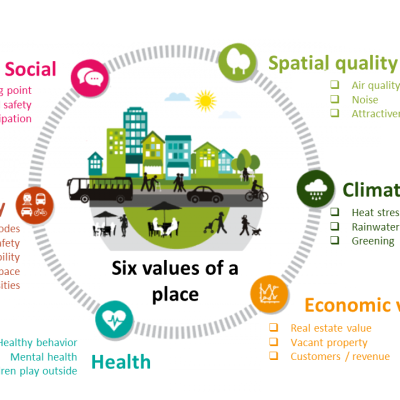Exploring Urban Futures: Amsterdam University of Applied Sciences Unveils Insights in 'Spatial Planning & City Design' for Our 'Focus On' Series.
Today's Partner

Susanne Balm
Project Leader
Sustainable City Logistics
Amsterdam University of Applied Sciences
Role within MoLo Hubs
Knowledge partner and responsible for the
cross-cutting topic "Spatial Planning & City Design"
Why are spatial planning & city design relevant aspects for MoLo Hubs?
Multifunctional hubs, like the ones that are piloted in MoLo Hubs, can be a solution to densify cities. The idea of these hubs is that it is a space-efficient solution. It will free up space for parking and turn it into space for pedestrians, cyclists, leisure and green, making our cities more healthy and liveable. Though, the hub itself also requires space, facilities and establishments. Residents, entrepreneurs and city planners may oppose to its development when the hub design does not fit within the surrounding architecture or when the use of the hub causes negative impacts in terms of noise, increased traffic and blocking of public space.
Hence, to gain support of the local community, it is important to consider the design and location of the hub as well as its maintenance during operation.
What are the key challenges when it comes to spatial planning & city design?
Making hubs more attractive, so that they are used and accepted, costs money and there is not always (directly) a business case for it. For example, we could make the hubs more green, offer shade or offer additional (social) services for vulnerable groups at the hub. But who will invest in this? Who will maintain it? The potential added value for the neighbourhood is difficult to quantify and monetarize.
Another challenge is the availability of space in the city, especially in urban areas that are already crowded. Making space for hubs may be more easy in urban areas that still need to be developed.
What are the potentials of spatial planning & city design when it comes to implementing logistics services at shared mobility hubs?
Adding logistics to mobility hubs can be a space-efficient solution and it can help in terms of visibility. If people already go to the hub for mobility services like shared vehicles, they get acquainted with the logistics functions like recycling options or parcel lockers. The assumption is that this will help in the chance that they will use it. We would like to use MoLo hubs pilots to explore whether this assumption is true.
Are there any good examples from the pilot areas?
We also look at possible additional functions that the hub can offer that are of value for the local community. A nice example from Mechelen is that the Hoppinpoints also offer bike repair services or information about public transport.
What is your vision for the impact of MoLo Hubs towards the aspect spatial planning & city design by the end of the project?
An idea is to develop a typology of hubs that shows under which spatial conditions a certain combination of functions could be combined at a hub, considering the characteristics of a neighbourhood and the added value that the hub can bring.
Source: Amsterdam University of Applied Sciences

